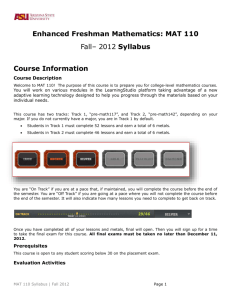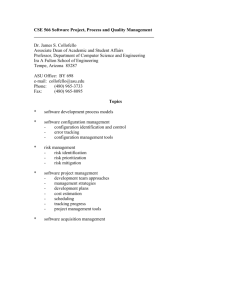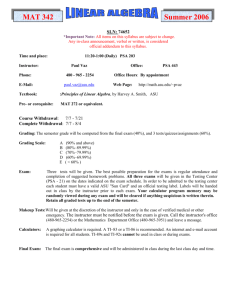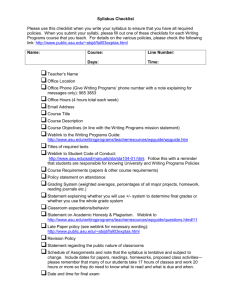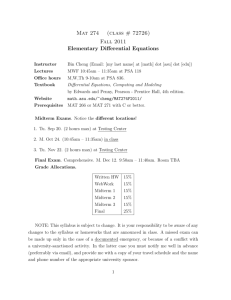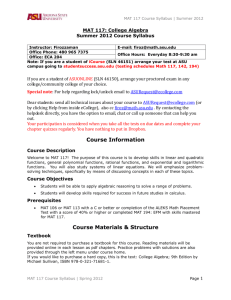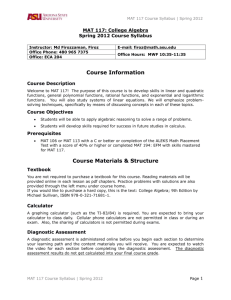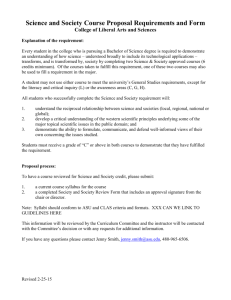Course Information - Arizona State University
advertisement
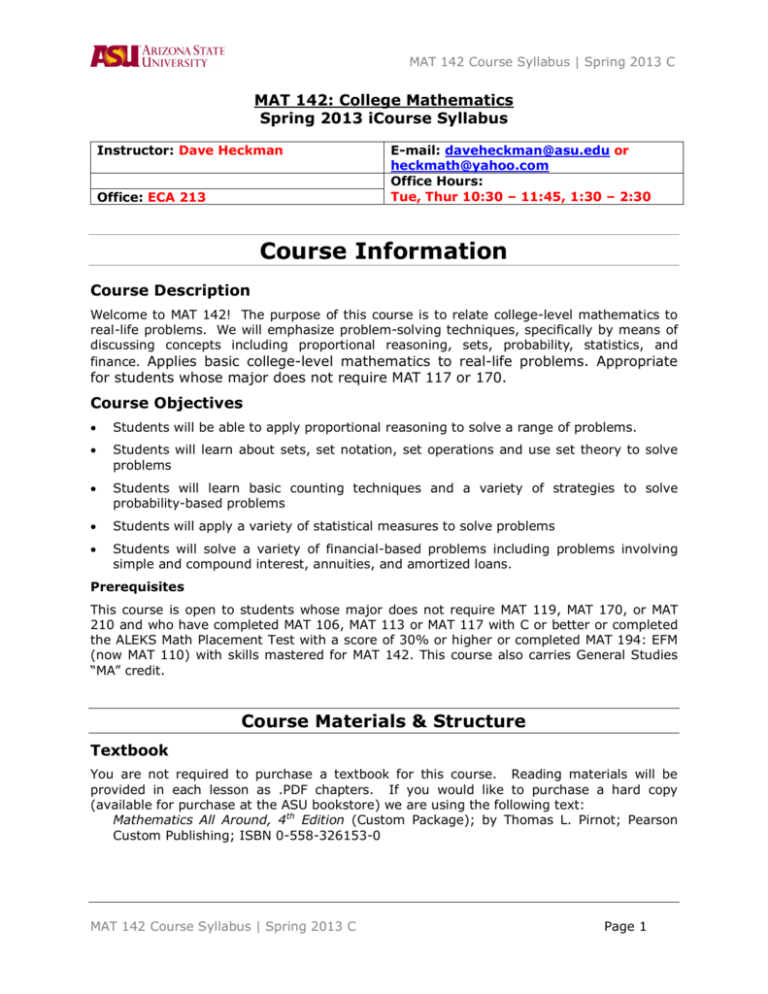
MAT 142 Course Syllabus | Spring 2013 C MAT 142: College Mathematics Spring 2013 iCourse Syllabus Instructor: Dave Heckman Office: ECA 213 E-mail: daveheckman@asu.edu or heckmath@yahoo.com Office Hours: Tue, Thur 10:30 – 11:45, 1:30 – 2:30 Course Information Course Description Welcome to MAT 142! The purpose of this course is to relate college-level mathematics to real-life problems. We will emphasize problem-solving techniques, specifically by means of discussing concepts including proportional reasoning, sets, probability, statistics, and finance. Applies basic college-level mathematics to real-life problems. Appropriate for students whose major does not require MAT 117 or 170. Course Objectives Students will be able to apply proportional reasoning to solve a range of problems. Students will learn about sets, set notation, set operations and use set theory to solve problems Students will learn basic counting techniques and a variety of strategies to solve probability-based problems Students will apply a variety of statistical measures to solve problems Students will solve a variety of financial-based problems including problems involving simple and compound interest, annuities, and amortized loans. Prerequisites This course is open to students whose major does not require MAT 119, MAT 170, or MAT 210 and who have completed MAT 106, MAT 113 or MAT 117 with C or better or completed the ALEKS Math Placement Test with a score of 30% or higher or completed MAT 194: EFM (now MAT 110) with skills mastered for MAT 142. This course also carries General Studies “MA” credit. Course Materials & Structure Textbook You are not required to purchase a textbook for this course. Reading materials will be provided in each lesson as .PDF chapters. If you would like to purchase a hard copy (available for purchase at the ASU bookstore) we are using the following text: Mathematics All Around, 4th Edition (Custom Package); by Thomas L. Pirnot; Pearson Custom Publishing; ISBN 0-558-326153-0 MAT 142 Course Syllabus | Spring 2013 C Page 1 MAT 142 Course Syllabus | Spring 2013 C Calculator At minimum, a hand-held scientific calculator is required for this course. A few of the recommended models include the TI-30XS Multiview, TI-34 Multiview, TI-36, TI-83, and TI84. A graphing calculator is not required. You are expected to bring your calculator to class daily. Cellular phone calculators and calculators on-line or on a computer are not permitted in class or during an exam. Also, the sharing of calculators is not permitted during exams. Diagnostic Assessment A diagnostic assessment is administered online before you begin each section to determine your learning path and the content materials you will receive. You are expected to watch the video for each section before completing the diagnostic assessment. The diagnostic assessment results are not used in the calculation of your final course grade. Knewton Study Center The information you receive in the Knewton Study Center could differ from your classmates depending on your results of the diagnostic quizzes and understanding of the course material. You are expected to work out solutions to problems and take notes while interacting with the online content just as if you were in a traditional lecture. You can use these notes as you prepare for your exams or in class for the problem solving sessions. All material in the Knewton Study Center must be completed by Tuesday, April 30. No credit will be given for work completed after April 30. Problem Solving Sessions Written problem solving activities are an integral part of learning mathematics. You will receive five problem sets via email. You must hand write the solutions to the problems. You will submit the solutions using the dropbox in Learning Studio (the class website). You should scan your solutions or take a picture of them and submit that image. You will need to make sure that you name and the date are on each page of your problem set. MAKE SURE THAT ALL INFO IS LEGIBLE! Exams You will take five unit exams during the semester according to the deadlines listed below. Based on the recommended pace of the course you should not have any trouble meeting these deadlines. Each exam will involve a mix of mechanical skills and conceptual reasoning. You only get a single attempt at each unit exam. Once you put in the exam password, your attempt has started and must be completed in 90 minutes. No exam scores will be dropped. The first four exams can be taken on your home computer in an unproctored setting. THE LAST EXAM MUST BE PROCTORED. You must take a proctored test in any of the Testing Centers run by the University Academic Success Programs. This option is at no charge to the student. It is highly recommended that you schedule to take an exam as soon as you start working on Unit 5. It is required for you to bring headphones to the computer lab for taking the exam. A lock down browser is required to take an exam. See the technology requirements section for a link to a browser and installation instructions. MAT 142 Course Syllabus | Spring 2013 C Page 2 MAT 142 Course Syllabus | Spring 2013 C It is not possible to access an exam without a password that will be provided by the instructor for the first four exams. The password for the last exam will be provided by the proctor. You should email your request for each password once you have completed half of the sections in a unit. Exam & Problem Set Unit 1 Exam & Prob Set 1 Unit 2 Exam & Prob Set 2 Unit 3 Exam & Prob Set 3 Unit 4 Exam & Prob Set 4 Unit 5 Exam & Prob Set 5 Last Day to Take Exam and deadline for Problem Set Monday, February 4, 2013 Monday, February 25, 3013 Monday, March 25, 2013 Monday, April 8, 2013 Tuesday, April 30, 2013 Course Design Click HERE (http://asuonline-dev.asu.edu/math/flowchart/142_flow.pdf) to see a graphic of the course flow for 142. Course Expectations & Student Resources Course Expectations You are expected to complete a minimum of 2 sections per week as outlined on the course schedule. Over the course of the semester, you are expected to remain on schedule and “On Track” as designated by your instructor. Students who are not on schedule or are “Off Track” by the day/time designated by your instructor may receive a loss of points for your participation grade. Attendance All First Year Mathematics courses have an attendance/participation policy. In an online course such as this one, any of the following is reason to receive a grade on EN for “nonattendance”. Failure to take any exam by the deadline. Failure to score at least 50% on 3 or more lessons before the deadline for taking that unit’s tests. A lesson is a single lesson in one of the sections (i.e.: lesson 1.2a in section 1.2 in unit 1), the syllabus quiz, or the required email. All students are required to email the instructor no later than 11:59 pm Sunday, January 13 as “attendance” for the first week of class. Any student who has not “attended” class during the first week of classes may be administratively dropped from the course. However, students should be aware that non-attendance will NOT automatically result in being dropped from the course. Thus, a student should not assume they are no longer registered for a course simply because they did not attend class during the first week. It is the student's responsibility to be aware of their registration status. MAT 142 Course Syllabus | Spring 2013 C Page 3 MAT 142 Course Syllabus | Spring 2013 C Students cannot be dropped for the course for non-attendance/non-participation once they have attended/participated in the class. Student Resources / Computer Lab Your primary resource for tutoring is the computer lab. During non-class and nontesting times, tutors will be available to answer questions for you regarding the course content. You can also visit the Student Success Center. Specific hours for when a MAT 142 tutor is available at the Student Success Center can be found on their webpage at: http://studentsuccess.asu.edu. If you own a laptop computer, you are encouraged to bring it with you to the computer lab when you are working on course content or taking an exam. The Technology Studio can check your laptop or personal computer free of charge to make sure you are ready to access all the course content from your computer. If you choose to use your laptop for exams, the Technology Studio can also assist you in installing the secure browser required for testing. You must wear headphones while in the computer lab and while using your computer in class. How to Succeed in this Course Staying on schedule according to schedule included below and “on track” is a critical component of student success in this course. Stay ahead of schedule and make sure you are aware of all the resources available to you that are listed in the syllabus and on the course site so you don’t fall behind. Check your ASU e-mail at least daily. Log in to the course site every day. MAT 142 Course Syllabus | Spring 2013 C Page 4 MAT 142 Course Syllabus | Spring 2013 C Course Schedule Week of 1/7 – 1/13 (1) 1/14 – 1/20 (2) 1/21 – 1/27 (3) 1/28 – 2/3 (4) To Do Deadline Email Instructor 11:59 pm MST on 1/13 Complete Getting Started Badge Complete Syllabus Quiz 1.1 – Approaching Problems 1.2a – Direct Proportions 1.2b – Solving with Proportions 1.3a – Understanding Percents 11:59 pm MST on 1/20 1.3b – Percent Problems 1.4a – Unit Conversions 11:59 pm MST on 1/27 1.4b – Conversions in the Real World 2.1a – Describing Sets 11:59 pm MST on 2/3 2.1b – Cardinality and Special Sets Take Exam 1 and turn in Problem set 1 no later than Monday, February 4. 2/4 Take Exam 1 no later than Monday, February 4. 2/4 – 2/10 (5) 2.2 – Relating Sets 2.3a – Operations with Two Sets 2.3b – Operations with Three Sets 2.4a – Two-set Survey Problems 2.4b – Three-set Survey Problems 2/11 – 2/17 (6) MAT 142 Course Syllabus | Spring 2013 C 2/4 start exam no later than 10:30 pm MST (max 90 minutes to complete exam) – Exams closes at 11:59 pm MST – exam must be completed by 11:59 pm MST 11:59 pm on 2/10 11:59 pm MST on 2/17 Page 5 MAT 142 Course Syllabus | Spring 2013 C 2/18 – 2/24 (7) 2/25 2/25 – 3/3 (8) 3/ 4 - 3/10 (9) 3/11 – 3/17 3.1 – Basic Counting Methods 3.2 – Understanding FCP 3.3 – How Many Ways? Take Exam 2 and turn in Problem set 2 no later than Monday, February 25. Take Exam 2 no later than Monday, February 25. 3.4 – How Likely? 3.5 – Combined Events 3.6 Working with Conditions 3.7 – Calculating Expected Value Spring Break 11:59 pm MST on 2/24 2/25 start exam no later than 10:30 pm MST (max 90 minutes to complete exam) – Exams closes at 11:59 pm MST – exam must be completed by 11:59 pm MST 11:59 pm MST on 3/3 11:59 pm MST on 3/17 11:59 pm MST on 3/17 3.6 Working with Conditions 3.7 – Calculating Expected Value 3/18 – 3/24 (10) 3/25 3/25 – 3/31 (11) 4.1a – Construction Data Visualizations 4.1b – Interpreting Data Visualizations 4.2a – Mean, Median, Mode 4.2b – Five-number Summary Take Exam 3 and turn in Problem set 3 no later than Monday, March 25 Take Exam 3 no later than Monday, March 25. 4.3 – Range and Standard Deviation of the Normal Curve 4.4a – The Normal Curve 4.4b – Applications of the MAT 142 Course Syllabus | Spring 2013 C 11:59 pm MST on 3/24 3/25 start exam no later than 10:30 pm MST (max 90 minutes to complete exam) – Exams closes at 11:59 pm MST – exam must be completed by 11:59 pm MST 11:59 pm MST on 3/31 Page 6 MAT 142 Course Syllabus | Spring 2013 C 4/1 – 4/7 (12) 4/8 4/8 – 4/14 (13) 4/15 – 4/21 (14) 4/22 – 4/30 (15) Normal Curve 5.1 – Time is Money 5.2 – Interest on Your Interest Take Exam 4 and turn in Problem set 4 no later than Monday, April 8. Take Exam 4 no later than Monday, April 8. 5.3 – Add-on and Daily Balance Methods 5.4 – The Annuity Formula Schedule Exam 5 (this does not mean take exam) – deadline to take exam is 4/30 5.5 – The Amortization Formula Take Exam 5 and turn in Problem set 5 no later than Tuesday, April 30. Review for Exam 5 Take Exam 5 no later than Tuesday, April 30. LAST DAY OF CLASSES April 30 11:59 pm MST 4/7 4/8 start exam no later than 10:30 pm MST (max 90 minutes to complete exam) – Exams closes at 11:59 pm MST – exam must be completed by 11:59 pm MST 11:59 pm MST on 4/14 11:59 pm MST on 4/21 Grading Policy Point Distribution 5 Unit Exams Problem Sets 5 Unit Badges Participation / Misc. Percentage 50% 25% 20% 5% MAT 142 Course Syllabus | Spring 2013 C Grade A+ A AB+ B BC+ C D E Grading Scale 97% or above 90% - 96.99% 89.5% - 89.99% 87% - 89.49% 80% - 86.99% 79.5% - 79.99% 77% - 79.49% 70% - 76.99% 60% - 69.99% < 60% Page 7 MAT 142 Course Syllabus | Spring 2013 C Key Semester Dates Drop/Add Deadline: Course Withdrawal Deadline: Sunday, January 13, 2013 Sunday, March 31, 2013 Additional Information The highest standards of academic integrity are expected of all students at all times. Violations of academic integrity include, but are not limited to, cheating, fabrication, tampering, plagiarism, or facilitating such activities. We will act very harshly against any acts of academic dishonesty. Students with disabilities should arrange to meet with me as soon as possible to arrange for reasonable accommodations for their learning needs. Students registered with DRC must notify the instructor at least two weeks prior to any exam deadline. Alternative arrangements for any religious observances, ASU sanctioned activity, or ASU student athlete obligations must be arranged with the instructor at least two weeks prior to the event. As a reminder, there are no extensions or makeups for exams after the exam close date. No individual extra credit assignments will be offered. ACADEMIC DISHONESTY In the “Student Academic Integrity Policy” manual, ASU defines “’Plagiarism” [as] using another's words, ideas, materials or work without properly acknowledging and documenting the source. Students are responsible for knowing the rules governing the use of another's work or materials and for acknowledging and documenting the source appropriately.” You can find this definition at: http://www.asu.edu/studentaffairs/studentlife/judicial/academic_integrity.htm#definitions Academic dishonesty, including inappropriate collaboration, will not be tolerated. There are severe sanctions for cheating, plagiarizing and any other form of dishonesty. Student Conduct Statement: Students are required to adhere to the behavior standards listed in Arizona Board of Regents Policy Manual Chapter V – Campus and Student Affairs: Code of Conduct (http://www.abor.asu.edu/1_the_regents/policymanual/chap5/5Section_C.pdf), ACD 125: Computer, Internet, and Electronic Communications (http://www.asu.edu/aad/manuals/acd/acd125.html), and the ASU Student Academic Integrity Policy (http://www.asu.edu/studentaffairs/studentlife/srr/index.htm). Students are entitled to receive instruction free from interference by other members of the Lab. If a student is disruptive, an instructor may ask the student to stop the disruptive behavior and warn the student that such disruptive behavior can result in withdrawal from the course. An instructor may withdraw a student from a course when the student's behavior disrupts the educational process under USI 201-10 http://www.asu.edu/aad/manuals/usi/usi201-10.html. MAT 142 Course Syllabus | Spring 2013 C Page 8 MAT 142 Course Syllabus | Spring 2013 C Please note the following links to ASU's http://provost.asu.edu/academicintegrity/policy MAT 142 Course Syllabus | Spring 2013 C academic integrity policy Page 9 MAT 142 Course Syllabus | Spring 2013 C Technology Requirements Email and Internet You must have an active ASU e-mail account and access to the Internet. All instructor correspondence will be sent to your ASU e-mail account using the course or roster email function. Please plan on checking your ASU email account daily for course related messages. This course uses Pearson LearningStudio for the facilitation of communications between faculty and students, submission of assignments, and posting of grades. This course site can be accessed through myASU at http://my.asu.edu Computer Requirements This course requires that you have access to a computer that can access the internet. You will need to have access to, and be able to use, the following software packages: The recommended web browser for these courses is Mozilla Firefox (http://www.mozilla.com/) o Adobe Acrobat Reader (free) (http://get.adobe.com/reader/) o Adobe Flash Player (http://www.adobe.com/products/flashplayer/) (free) o Microsoft Office (http://office.microsoft.com/) or a program that reads Powerpoint, Word, and Excel documents. A popular free alternative is Open Office. (http://www.openoffice.org/) o Pearson Lockdown Browser (http://asuonline-dev.asu.edu/math/mmllockdown/mmldb.html) You are responsible for having a reliable computer and internet connection throughout the course. Support Technical Support See the Technical Support link on the upper right of the student website for contact information. Scheduling your Math Test Click here to schedule your test (face-to-face students only) (http://asuonline-dev.asu.edu/math/schedule-test/schedule-test.html) Cancelling your Math Test Click here for information on how to cancel your test appointment. (http://asuonline-dev.asu.edu/math/schedule-test/cancel-appointment.html) MAT 142 Course Syllabus | Spring 2013 C Page 10 MAT 142 Course Syllabus | Spring 2013 C Tutoring Tutoring will be available during various hours in each of the ASU Math Labs locations. The hours will vary between locations. Please check the math lab schedule for tutoring hours on each campus. Additional math tutoring assistance will be available on each of the ASU campus locations. Please check with the Math Tutoring Center on the Tempe campus and the Student Success Centers on the Downtown Phoenix, Polytechnic and West campus for additional math tutoring availability and hours: http://studentsuccess.asu.edu. Please note that these locations may be subject to change, depending on room availability. Each of the tutors working in the Math Labs, Student Success Centers, Math Tutoring Center actively engage the students who come in for assistance. The tutors are trained in techniques of engagement, discussion, assessment, and troubleshooting in order to create a positive learning environment for all students. Students who are actively engaged using techniques of reading, writing, listening, and speaking with their applications of materials are more likely to be comfortable in the Math Lab space, interacting with tutors and professors in that same space, while retaining the content material that they will need to apply to future Math courses and computations in non-Math courses, as well. Academic Integrity ASU expects and requires all its students to act with honesty and integrity, and respect the rights of others in carrying out all academic assignments. For more information on academic integrity, including the policy and appeal procedures, please visit http://provost.asu.edu/academicintegrity and the Student Conduct Statement below. Conduct Students are required to adhere to the behavior standards listed in the Arizona Board of Regents Policy Manual Chapter V – Campus and Student Affairs: Code of Conduct (http://www.azregents.edu/policymanual/default.aspx) ACD 125: Computer, Internet, and Electronic Communications (http://www.asu.edu/aad/manuals/acd/acd125.html) ASU Student Academic Integrity Policy. (http://provost.asu.edu/files/AcademicIntegrityPolicyPDF.pdf) Students are entitled to receive instruction free from interference by other members of the Lab. If a student is disruptive, an instructor may ask the student to stop the disruptive behavior and warn the student that such disruptive behavior can result in withdrawal from the course. An instructor MAT 142 Course Syllabus | Spring 2013 C Page 11 MAT 142 Course Syllabus | Spring 2013 C may withdraw a student from a course when the student's behavior disrupts the educational process under USI 201-10. Appropriate Labroom behavior is defined by the instructor. This includes the number and length of individual messages online. Course discussion messages should remain focused on the assigned discussion topics. Students must maintain a cordial atmosphere and use tact in expressing differences of opinion. Inappropriate discussion board messages may be deleted if an instructor feels it is necessary. Student access to the course Send Email feature may be limited or removed if an instructor feels that students are sending inappropriate electronic messages to other students in the course. Accessibility Statement In compliance with the Rehabilitation Act of 1973, Section 504, and the Americans with Disabilities Act of 1990, professional disability specialists and support staff at the Disability Resource Centers (DRC) facilitate a comprehensive range of academic support services and accommodations for qualified students with disabilities. DRC staff coordinate transition from high schools and community colleges, in-service training for faculty and staff, resolution of accessibility issues, community outreach, and collaboration between all ASU campuses regarding disability policies, procedures, and accommodations. Students who wish to request an accommodation for a disability should contact the Disability Resource Center (DRC) for their campus. Tempe Campus Polytechnic Campus http://www.asu.edu/studentaffairs/ed/drc/http://www.asu.edu/studentaffairs/ed/drc/ 480-965-1234 (Voice) 480-727-1165 (Voice) 480-965-9000 (TTY) 480-727-1009 (TTY) West Campus Downtown Phoenix Campus http://www.west.asu.edu/drc/ http://campus.asu.edu/downtown/DRC University Center Building (UCB), Room 130 University Center Building, Suite 160 602-543-8145 (Voice) 602-496-4321 (Voice) 602-496-0378 (TTY) International Students Assistance for international students can be found at http://global.asu.edu/current MAT 142 Course Syllabus | Spring 2013 C Page 12 MAT 142 Course Syllabus | Spring 2013 C Syllabus Disclaimer Instructors view the course syllabus as an educational contract between the instructor and the students. Every effort will be made to avoid changing the course schedule but the possibility exists that unforeseen events will make syllabus changes necessary. Instructors reserve the right to make changes to the syllabus as deemed necessary. Students will be notified in a timely manner of any syllabus changes via email or in the course site Announcements. Please remember to check your ASU email and the course site Announcements often. MAT 142 Course Syllabus | Spring 2013 C Page 13
